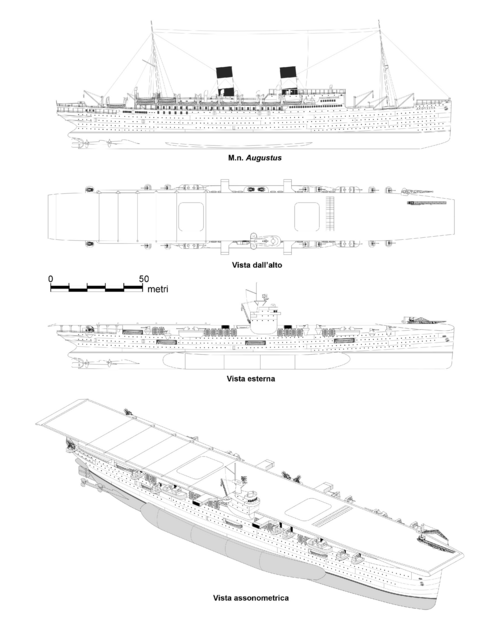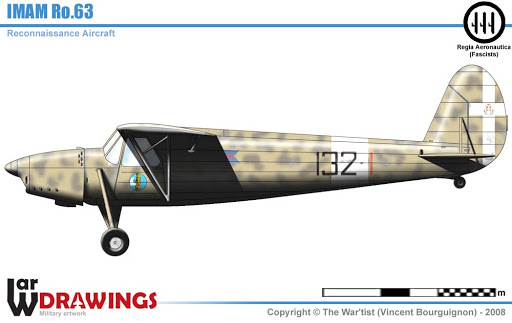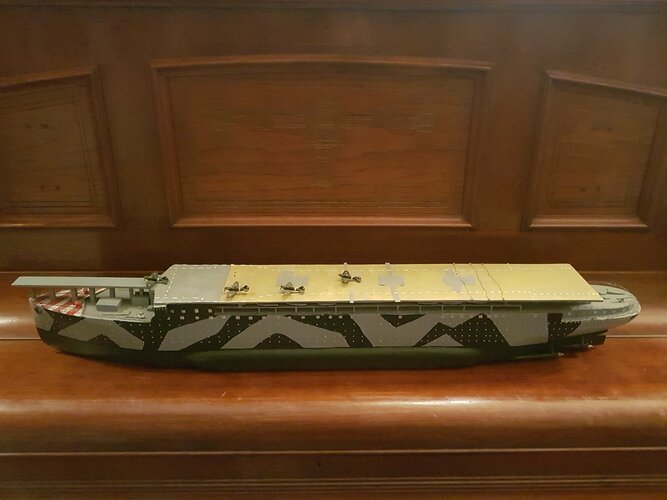archipeppe
ACCESS: Top Secret
- Joined
- 18 October 2007
- Messages
- 2,431
- Reaction score
- 3,152

Is this a new book? Additional material from earlier books?
This over-deck bow catapult looks... unusual. What was the reason for such arrangement? They wanted a rotating catapult?
This also lead us to hypotize the presence of a crane, placed into an outboard point to raise the aircraft above the catapult, essentially like the ones onboard LITTORIO.This over-deck bow catapult looks... unusual. What was the reason for such arrangement? They wanted a rotating catapult?
Not exactly, the point is that the Demag catapults already used for AQUILA were off question for SPARVIERO, this fact lead to a (possible) usage of the same Gagnotto catapult exploited by LITTORIO class, as we know their upgrade should allow to launch the RE 2001 OR as well as the RE 2000.
Not exactly, the point is that the Demag catapults already used for AQUILA were off question for SPARVIERO, this fact lead to a (possible) usage of the same Gagnotto catapult exploited by LITTORIO class, as we know their upgrade should allow to launch the RE 2001 OR as well as the RE 2000.
Since the SPARVIERO was late than AQUILA at that point Ansaldo already knew that no additional German catapults were available.
Hm. So, the shortage of components, or the construction of the ship did not allow to install them?
Hm! Didn't knew about that. But what they wanted to do with it? What was the point to put it on deck?Furthermore, at least initially, the SPARVIERO would not have any catapult at all, considering the first aircraft considered to be onboard was the IMAM Ro 63, a super STOL two seat single propeller, a sort of Italian Storch that doesn't need any catapult at all.
The catapult launch would not exclude the ship maneuvering into the wind to launch the aircrafts, especially considered the very low top speed (only 18 knots) of the SPARVIERO, since (differently from AQUILA) the diesel engines would be the same ones of the cruiser AUGUSTUS.So the Italian carriers always assumed a catapult launch, not just steering the ship into the wind at top speed and launching down the deck?
The catapult Gagnotto was on the deck essentially in the very same way of their bow location within the LITTORIO class, the point is that is an element added lately into the project and to integrate it with the ship without any modification to the Gagnotto's project.Hm! Didn't knew about that. But what they wanted to do with it? What was the point to put it on deck?Furthermore, at least initially, the SPARVIERO would not have any catapult at all, considering the first aircraft considered to be onboard was the IMAM Ro 63, a super STOL two seat single propeller, a sort of Italian Storch that doesn't need any catapult at all.
No, I meant the IMAM Ro 63; what they supposed to do with this small plane on carrier?The catapult Gagnotto was on the deck essentially in the very same way of their bow location within the LITTORIO class, the point is that is an element added lately into the project and to integrate it with the ship without any modification to the Gagnotto's project.
Oh, I see.No, I meant the IMAM Ro 63; what they supposed to do with this small plane on carrier?The catapult Gagnotto was on the deck essentially in the very same way of their bow location within the LITTORIO class, the point is that is an element added lately into the project and to integrate it with the ship without any modification to the Gagnotto's project.
Ah, understood.The Ro 63 was envisioned both in recce and antisubmarine roles.
What it is not clear is if SPARVIERO would have a mixed squadron. Since various documents talk about only 35 Re 2001 OR and since SPARVIERO's hangar was bigger than the AQUILA's one, there is room for another 30-35 aircrafts.Ah, understood.The Ro 63 was envisioned both in recce and antisubmarine roles.
If I recall correctly, Sparivero was intended mainly to serve as escort carrier to protect convoys?What it is not clear is if SPARVIERO would have a mixed squadron. Since various documents talk about only 35 Re 2001 OR and since SPARVIERO's hangar was bigger than the AQUILA's one, there is room for another 30-35 aircrafts.
Maybe Supermarina thought about 35 Re 2001 OR and still 35 Ro 63....

This does not look like it would be effective for either strikes or ASW, though. Did it have armament or a payload?The Ro 63 has an interesting history: it was born by a rfq issued by Regia Aeronautica with the same purpose of Fieseler Fi 156 Storch and the same Hirth HM 508 engine.
The aircraft was designed by Giuseppe Galasso and built by IMAM factory in Naples (the same one that produced the Ro 43 idro), in June 1940.
The aircraft performed so good that were immediately ordered 100 units, 60 of them devoted to be onboard the SPARVIERO.
At the end of the WWII only 6 were built mainly for the difficulty to get the Hirth engines by Germany, and no one of them was tested onboard or in Perugia facility were Italians were trying arrested landings.
View attachment 660619
As far as I know the Ro 63 was without armament. I suppose it would be exploited in hunter role leaving the killer role to destroyers or eventually to the Re 2001 OR armed with Silurotto (small torpedo).This does not look like it would be effective for either strikes or ASW, though. Did it have armament or a payload?The Ro 63 has an interesting history: it was born by a rfq issued by Regia Aeronautica with the same purpose of Fieseler Fi 156 Storch and the same Hirth HM 508 engine.
The aircraft was designed by Giuseppe Galasso and built by IMAM factory in Naples (the same one that produced the Ro 43 idro), in June 1940.
The aircraft performed so good that were immediately ordered 100 units, 60 of them devoted to be onboard the SPARVIERO.
At the end of the WWII only 6 were built mainly for the difficulty to get the Hirth engines by Germany, and no one of them was tested onboard or in Perugia facility were Italians were trying arrested landings.
View attachment 660619
Dave
As what apperared by the scarce documentation available (see the latest Cosentino's book) Ansaldo decided to split the funnel in four, where the small island came in the middle, in order to avoid long discharge funnel to the stern, like the Japanese aircraft carriers.Does the carrier have funnels on both sides???
Credo sia modello originale, post 1940. Lunghezza 97 cm (1/240), scafo in massello, pannelli di compensato per ponte, lamiera per aerei, filo metallico per corrimano, carta per oblò e ascensori.

I suggest you to read such thread from the start.Queste sono le notizie da me conosciute:
Nel 1936 fu approntato il progetto per trasformare in portaerei ausiliaria la motonave passeggeri Augustus. Il progetto fu sviluppato dal colonnello del Genio navale Luigi Gagnotto. L'idea fu abbandonata fino al 1941, quando il disastro della battaglia di Capo Matapan, in cui la marina italiana perse in un sol colpo tre incrociatori pesanti, rese chiaro l'apporto significativo che un uso coordinato dell'aeronautica poteva dare e venne deciso urgentemente di dotare di una portaerei la Regia Marina. La trasformazione del transatlantico "Augustus" in portaerei venne ordinata nel 1941. Il progetto riprendeva quello sviluppato dal colonnello del Genio navale Luigi Gagnotto ed i lavori di trasformazione iniziarono nel settembre del 1942 nei Cantieri Ansaldo di Genova. Quindi la colorazione degli aerei e la mimetizzazione dello scafo come le strisce rosse di riconoscimento mi sembrano coerenti. Il modello è del tutto rispondente con i disegni di progetto ufficiali. (mi scuso per traduzione google)
In 1936 the project was prepared to transform the Augustus passenger motor ship into an auxiliary aircraft carrier. The project was developed by the Colonel of the Naval Engineers Luigi Gagnotto. The idea was abandoned until 1941, when the disaster of the Battle of Cape Matapan, in which the Italian navy lost three heavy cruisers in one fell swoop, made clear the significant contribution that a coordinated use of the air force could make and it was decided. urgently to equip the Regia Marina with an aircraft carrier. The transformation of the transatlantic "Augustus" into an aircraft carrier was ordered in 1941. The project resumed the one developed by the Colonel of the Naval Engineers Luigi Gagnotto and the transformation works began in September 1942 in the Ansaldo Shipyards in Genoa. So the coloring of the planes and the camouflage of the hull as well as the red stripes of recognition seem consistent to me. The model fully complies with the official project drawings. (sorry for google translation)
Superb.Here there are some SPARVIERO updated drawings I've realized for the book "Dal Piemonte al Trieste, portaerei e portaelicotteri della Marina Italiana" (From Piedmont to Trieste, aircraftcarriers and helicopter carriers of the Italian Navy), written by the Rear Admiral (Ret.) Michele Cosentino and printed by the Historical Office of the Italian Navy (only in Italian language):
Dal Piemonte al Trieste. Portaerei e portaelicotteri della Marina Italiana : Cosentino, Michele: Amazon.it: Libri
Dal Piemonte al Trieste. Portaerei e portaelicotteri della Marina Italiana : Cosentino, Michele: Amazon.it: Libriwww.amazon.it
View attachment 660627
